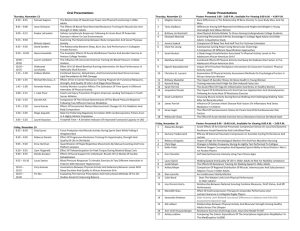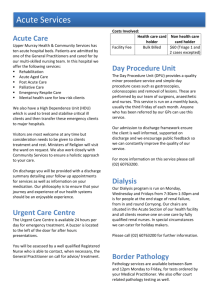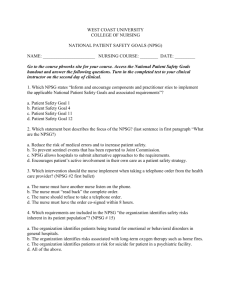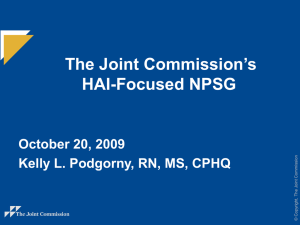Applying the 2013 National Patient Safety Goals in Acute Care
advertisement
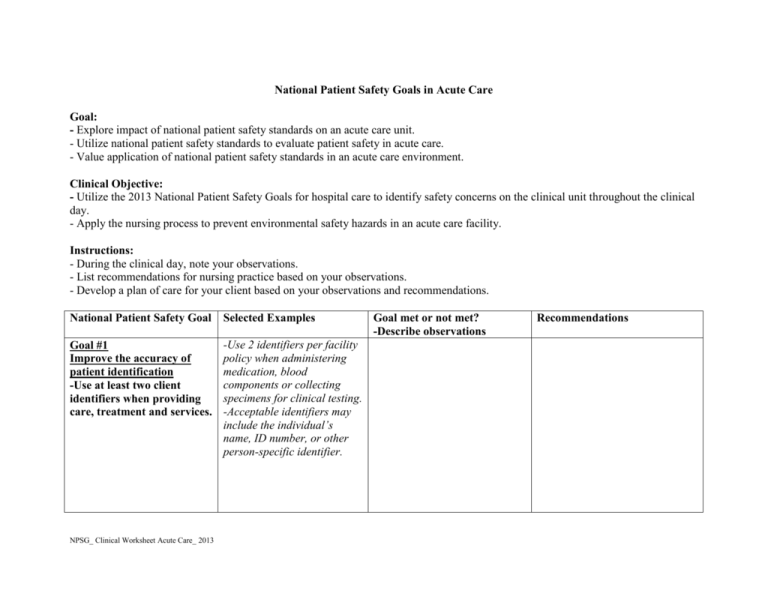
National Patient Safety Goals in Acute Care Goal: - Explore impact of national patient safety standards on an acute care unit. - Utilize national patient safety standards to evaluate patient safety in acute care. - Value application of national patient safety standards in an acute care environment. Clinical Objective: - Utilize the 2013 National Patient Safety Goals for hospital care to identify safety concerns on the clinical unit throughout the clinical day. - Apply the nursing process to prevent environmental safety hazards in an acute care facility. Instructions: - During the clinical day, note your observations. - List recommendations for nursing practice based on your observations. - Develop a plan of care for your client based on your observations and recommendations. National Patient Safety Goal Selected Examples Goal #1 Improve the accuracy of patient identification -Use at least two client identifiers when providing care, treatment and services. -Use 2 identifiers per facility policy when administering medication, blood components or collecting specimens for clinical testing. -Acceptable identifiers may include the individual’s name, ID number, or other person-specific identifier. NPSG_ Clinical Worksheet Acute Care_ 2013 Goal met or not met? -Describe observations Recommendations National Patient Safety Goal Selected Examples Goal # 2 Improve the effectiveness of communication among caregivers -Report critical results of tests and diagnostic procedures on a timely basis. -What is the procedure for managing critical results of tests and diagnostic procedures? (Ex: radiology reports, lab values, etc.) Goal # 3: Improve the safety of using medications -Maintain and communicate accurate patient medication information. -Locate the admission medication reconciliation form. Compare this list to the current Mediation Administration Record. Are there any discrepancies or omissions? -How is the patient/family informed about medication reconciliation at the time of discharge? NPSG_ Clinical Worksheet Acute Care_ 2013 Goal met or not met? -Describe observations Recommendations National Patient Safety Goal Selected Examples Goal #7: Reduce the risk of health care-associated infections -Comply with current Centers for Disease Control and Prevention hand hygiene guidelines. -Implement evidence based practices to prevent health care associated infections due to multidrug resistant organisms. -Implement evidence based practices for preventing surgical site infections. -Proper use of gloves and Personal Protective Equipment -Urinal not on over bed table with meal tray -Linens properly disposed (not on floor) -Personal care items identified and stored appropriately -How are hand hygiene, contact precautions, cleaning and disinfecting patient care equipment implemented to prevent the spread of HAIs? -What policies and procedures are implemented to prevent surgical site infections? (Ex: patient/family education, skin prep with clipper, depilatories or antimicrobial agents, etc.) Goal met or not met? -Describe observations Recommendations The Joint Commission. (2013). National patient safety goals: Hospital accreditation program. Retrieved from http://www.jointcommission.org/assets/1/18/NPSG_Chapter_Jan2013_HAP.pdf NPSG_ Clinical Worksheet Acute Care_ 2013 Care Plan Format Nursing Diagnosis: Goals: Short Term Long Term Interventions: Evaluation: NPSG_ Clinical Worksheet Acute Care_ 2013 Rationale: Student Evaluation: Applying the 2013 National Patient Safety Goals in Acute Care 1. How useful did you find this activity in your understanding of the 2013 National Patient Safety Goals for Acute Care? Exceptional 4 Good 3 Satisfactory 2 Unsatisfactory 1 N/A 2. How useful did you find this activity in applying the nursing process to prevent safety hazards for patients in acute care? Exceptional 4 Good 3 Comments: NPSG_ Clinical Worksheet Acute Care_ 2013 Satisfactory 2 Unsatisfactory 1 N/A




